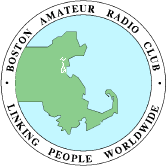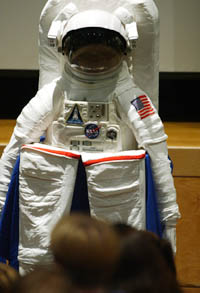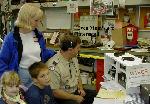 The Massachusetts SATERN EOC, at Mass. Div. HQ’s. was the designated Metro-Boston District EOC for the EMass. ARRL ARES/RACES SET conducted on November 9th. The Metro-Boston ARES DEC, Bill Ricker, N1VUX, was in command, assisted by both SATERN Team Leader, Frank Murphy, N1DHW and BERT Leader, Rick DeSisto, NG1L. ( Boston ARC ” Emergency Response Team”)…The purpose of this season’s drill was to test the ability of Primary Field Teams (PFT’s) to tactically communicate without the use of repeaters. Additionally, having PFT’s relay traffic from outlying district EOC’s and PFT’s to Metro-Boston EOC and MEMA. All tactical traffic between field teams and EOC’s was passed using 2m, 6m, and 70cm simplex only. Traffic between outlying District EOC’s and Mass. State Emergency Management sites was passed using RACES NTS formal HF messaging on 6 and 40 meters. (NVIS)
The Massachusetts SATERN EOC, at Mass. Div. HQ’s. was the designated Metro-Boston District EOC for the EMass. ARRL ARES/RACES SET conducted on November 9th. The Metro-Boston ARES DEC, Bill Ricker, N1VUX, was in command, assisted by both SATERN Team Leader, Frank Murphy, N1DHW and BERT Leader, Rick DeSisto, NG1L. ( Boston ARC ” Emergency Response Team”)…The purpose of this season’s drill was to test the ability of Primary Field Teams (PFT’s) to tactically communicate without the use of repeaters. Additionally, having PFT’s relay traffic from outlying district EOC’s and PFT’s to Metro-Boston EOC and MEMA. All tactical traffic between field teams and EOC’s was passed using 2m, 6m, and 70cm simplex only. Traffic between outlying District EOC’s and Mass. State Emergency Management sites was passed using RACES NTS formal HF messaging on 6 and 40 meters. (NVIS)
The SATERN EOC was manned by 6 SATERN members including the Massachusetts SATERN Coordinator, Bill Foley, kb1glf. One of the Boston canteens was manned by Rick Meuse, N1HID, and equipped for HF and vhf/uhf communications, and designated as Boston Tactical Remote Vehicle.
PFT’s were organized from the Boston Amateur Radio Club ” Emergency Response Team”, and were dispatched to two remote “high” areas outside Metro-Boston. Many of this group, 30 strong, are SATERN members; some of whom were active at “Ground Zero”. Individual “mobile and home players” provided tactical traffic related to “simulated emergency conditions/situations” that could be arise around Metro-Boston”. Additionally, the town of Hingham’s Emergency Management EOC was tied in, since it is located within contact range of the “Cape Cod and Islands District”. It was manned by the EM, Mark Duff, KB1EKN, the Hingham Deputy Fire Chief, and a radio officer.
Radio Equipment Used:
EOC – SATERN/METRO BOSTON
Yaesu FT900, Icom 706MKIIG, Icom 2100, Knwd TM-G707, Knwd 315A and individual Ht’s, and EOC scanners.
The SA location, 5 stories high, had a 5 band vertical, 6 mtr vertical, and a 40 mtr dipole(NVIS), along with 2, 220, and 440 vertical. (G5RV not used)
Commercial Power was used; however multiple rechargeable marine batteries and generators were available.
Tactical Remote Vehicle – A30:
Icom 706MKIIG, Knwd dual bander, Ht’s, and truck’s scanners. This vehicle is also equipped with direct Fire Alarm communications with Metro-Boston.
HF was with an Outbacker Antenna and trucks HF whip. VHF/UHF was with truck mounted antennas and mobile magnet mounts.
Primary Field Teams –
North – Located at Chelsea Veterans Home (Malone Park)
4 BERT/SATERN Members
NG1L ~ Rick – BERT Team Leader
AA1XS ~ James
N1LRT – Paul
KA1RDZ – Dan Equipped with 2 – 706 MKIIG (Mobile Verticals) / and dual band mobiles
South/West – Located at Larz Anderson Park, Brookline (BARC FD Site)
WA1IDA ~ Bob
N1ZKR ~ Paul / Pres. BARC
KB1IBG ~ Walter
Results and What We Learned:
The drill was a success, but not without its problems.
First, the drill as outlined, proved that we (SATERN and BERT) could communicate successfully to State EM without the use of repeaters in the Eastern Mass. Section. The SATERN EOC was able to directly communicate with all Mass. Emergency Management Agency locations on air. We were also able to communicate with all of our PFT’s, our Tactical Vehicle on HF, and the Hingham EOC on both HF and VHF simplex. The DEC used 6 meters to conduct drill discussions with the SEC, w1mpn. Additionally, we received and passed traffic from outlying district PFT’s, and also passed American Red Cross traffic from members of the Western Mass. Section, who were conducting an American Red Cross Hospital drill at the same time.
We learned that once our Primary 40m (NVIS) frequency was taken over by a non-participating slow-scan video station, that the secondary HF frequency became too crowded. (needs Net Control Operator) The primary Tactical VHF frequency was also too crowded. (it also needed a Net Control)
The Frequency Table provided was adequate, but not utilized correctly by most.
While the locations selected for the remote sites were optimum for individual team communications, today’s high power equipment, good antennas, and the presence of a “lift condition”, created a condition on simplex similar to most DX pile-ups. Without a Net Control Operator to sort out the hailing stations and directing us to alternate frequencies to pass traffic, weaker, distant stations were not recognized, or if they were on alternate frequencies, they were not heard. Emphasis must be placed on proper use of hailing frequencies/initial contact freq’s, with direction to an alternate by a NCS. (Thought should be given by Section Manager and SEC, to assigning individual club simplex frequencies for better hailing.)
The next step for our SATERN/BERT Group must be to test our ability to communicate within the ring of “high ground”. We must dispatch mobile operators, or the canteen, to many of the shelters, hospitals, and local EOC’s to recognize those problem communication area’s we may encounter in a real world disaster in Metro-Boston . Also, the equipment used at the EOC was provided by SATERN members and took considerable time to transport, erect antennas and set-up. The Salvation Army Mass. Division MUST purchase its own equipment, and provide a permanently equipped in house EOC location, that can be opened and manned in a reasonable time to be able to respond quickly. The Sharon, Mass. “Camp Wonderland” should also be equipped and tested as an alternate EOC location.
Some areas we have to work-on are:
1 – separation of EOC operators (too distracting hearing multiple traffic)
2 – assign tactical calls to our own PFT’s for easier recognition of hailing
3 – assign a recorder to each operator, and a separate NTS writer for traffic
4 – build a retractable operating shelf in the canteen for HF radio equipment
5 – wire external antenna connectors
6 – provide seating for the mobile operator.
7 – SOP for SATERN and BERT teams/ tested and distributed to all members.
8 – better participation of club members to drill training efforts. Only 12 members participated from BERT,40%, and 8% of total BARC membership.
9 – request additional “home/mobile players” participate in next drill to test real world LOAD on EOC’s ability to steer and pass tactical info correctly.
10- establish a list of HF hailing freq’s to other New England SATERN and American Red Cross EOC’s.




 The Massachusetts SATERN EOC, at Mass. Div. HQ’s. was the designated Metro-Boston District EOC for the EMass. ARRL ARES/RACES SET conducted on November 9th. The Metro-Boston ARES DEC, Bill Ricker, N1VUX, was in command, assisted by both SATERN Team Leader, Frank Murphy, N1DHW and BERT Leader, Rick DeSisto, NG1L. ( Boston ARC ” Emergency Response Team”)…The purpose of this season’s drill was to test the ability of Primary Field Teams (PFT’s) to tactically communicate without the use of repeaters. Additionally, having PFT’s relay traffic from outlying district EOC’s and PFT’s to Metro-Boston EOC and MEMA. All tactical traffic between field teams and EOC’s was passed using 2m, 6m, and 70cm simplex only. Traffic between outlying District EOC’s and Mass. State Emergency Management sites was passed using RACES NTS formal HF messaging on 6 and 40 meters. (NVIS)
The Massachusetts SATERN EOC, at Mass. Div. HQ’s. was the designated Metro-Boston District EOC for the EMass. ARRL ARES/RACES SET conducted on November 9th. The Metro-Boston ARES DEC, Bill Ricker, N1VUX, was in command, assisted by both SATERN Team Leader, Frank Murphy, N1DHW and BERT Leader, Rick DeSisto, NG1L. ( Boston ARC ” Emergency Response Team”)…The purpose of this season’s drill was to test the ability of Primary Field Teams (PFT’s) to tactically communicate without the use of repeaters. Additionally, having PFT’s relay traffic from outlying district EOC’s and PFT’s to Metro-Boston EOC and MEMA. All tactical traffic between field teams and EOC’s was passed using 2m, 6m, and 70cm simplex only. Traffic between outlying District EOC’s and Mass. State Emergency Management sites was passed using RACES NTS formal HF messaging on 6 and 40 meters. (NVIS)  The Boston Amateur Radio Club’s recent JOTA operation garnered some great publicity in the form of an article and two photos in the
The Boston Amateur Radio Club’s recent JOTA operation garnered some great publicity in the form of an article and two photos in the